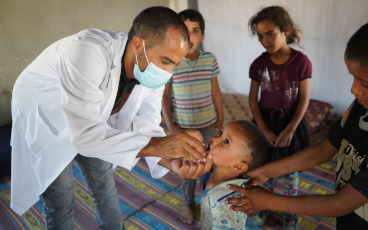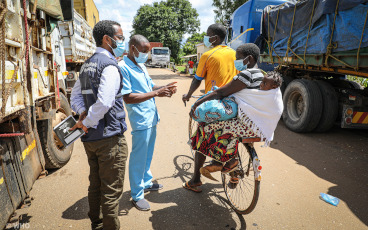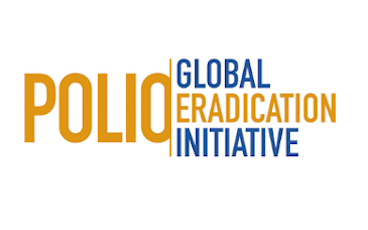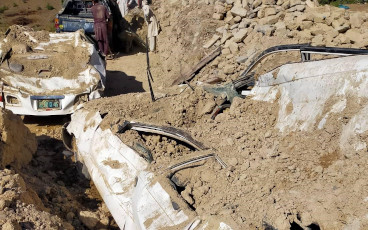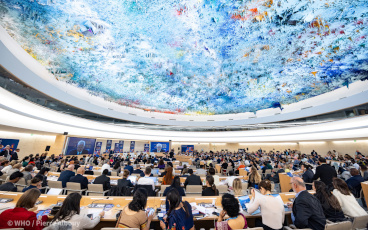When 2 does not equal 2
The importance of detecting type 2 polioviruses ‘post-switch’

3 February 2017 – In April 2016, the type 2 poliovirus component of trivalent oral polio vaccine (OPV) was successfully removed from routine immunization programmes around the world, through the globally-synchronized switch from trivalent to bivalent OPV (containing only type 1 and 3 serotypes). Since then, surveillance for type 2 polioviruses from any source globally has been intensified. Why is this important? And how significant is the detection of type 2 strain in a post-switch world?
Does 2 really equal 2? (Not in terms of a public health risk)
For a number of months following the switch from trivalent OPV to bivalent OPV, the detection of type 2 poliovirus was always anticipated. That is because children who had received the last, residual doses of trivalent OPV were always going to excrete the type 2 virus for a limited amount of time – as happens with any oral polio vaccine. Hence, the detection of such ‘Sabin 2 like’ virus strains, or SL-2 for short as they are known, for a limited time following the switch is not unusual or unexpected.
Quite the opposite, in fact. Detection of such strains simply means that surveillance for them is functioning as it should. SL-2s are essentially the same, benign virus strains originally contained in the trivalent OPV formulation, and do not pose a public health risk. In the vast majority of such detections, these strains are self-limiting, and simply die out without incidence.
On extremely rare occasions, and under certain circumstances (usually a combination of large populations, low immunity levels and inadequate sanitation infrastructure), an SL-2 can continue to transmit from child to child, as it continues to find susceptible children. As it transmits in such a manner, it undergoes genetic changes, and if it is allowed to transmit for a sufficiently long time, it can genetically change to such a degree that it has again attained a level of neurovirulence to where it can cause paralysis. Such a strain is then known as a vaccine-derived poliovirus type 2 (VDPV2).
Again, in most cases, such VDPV2s are self-limiting, meaning that in a population with good routine immunization levels, the strain will not actually be significant from a public health point of view, and will not cause an outbreak.
However, given its potential to cause cases, a thorough public health risk analysis is conducted, to determine if an immunization response with either inactivated polio vaccine (IPV), or monovalent OPV type 2 (mOPV2) is warranted or needed. If overall immunity levels are strong, and strong disease surveillance in place, no specific or a very limited immunization response is necessary. Under certain circumstances though, a pre-emptive outbreak response is conducted, to make absolutely certain that the virus does not begin to cause an outbreak.
An example of this is recent detection of a VDPV2 in Mozambique. Even though routine immunization levels in Mozambique are high, the VDPV2 was detected in a province with known gaps, and where a previous VDPV had caused an outbreak in 2011. Therefore, authorities opted to implement an immunization response with mOPV2, to boost immunity among children.
Finally, there is what is known as a ‘circulating’ VDPV2, or cVDPV2 for short. Such cVDPV2s are essentially outbreaks, with clear evidence that this virus strain, which is strong enough to cause cases, is circulating in a community and does indeed pose a public health risk to the immediate or even neighbouring communities. As it is a confirmed outbreak, an immunization response is almost always necessary, either with IPV, mOPV2 or a combination of both. An example of this are two separate cVDPV2 outbreaks currently affecting northern Nigeria, one in Sokoto state and one in Borno state. Outbreak response with mOPV2 is being conducted in response.
The detection of type 2 viruses at this time is not unusual or unexpected, though it is important to ensure any such virus is rapidly detected, its public health risk assessed and – if needed – responded to. Though it is a safe assumption that the more time elapses between the detection of a type 2 strain and when the switch happened in April 2016, the more significant such strains will become. In other words, a detection of a type 2 strain in 2017 is unlikely to be due to ongoing excretion of residual trivalent OPV vaccine-virus, but rather the emergence of some form of a VDPV2.
The name of the game is: securing not just a polio-free world, but indeed a lasting one.


